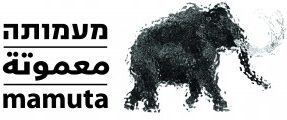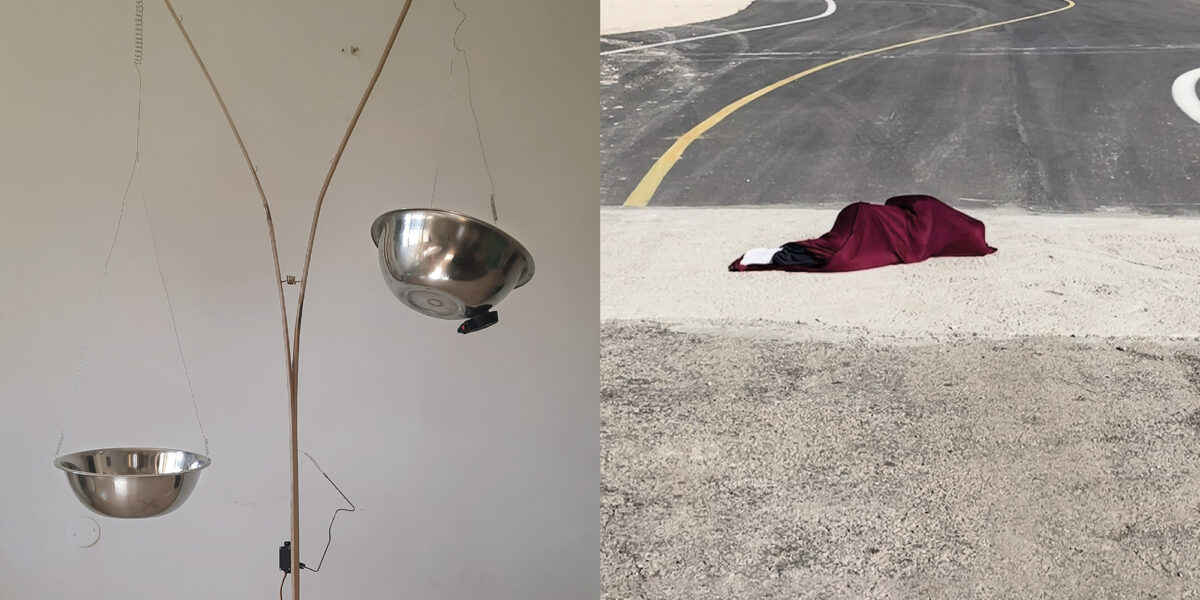Naama Mokady, Eitan Haviv
Curator: Maayan Sheleff
21.02.25 - 11.04.25
Lundqvist | Naama Mokady
In the exhibition “Lundqvist” Naama Mokady creates a performative documentary space that is both personal and biographical, while echoing the exposed nerve of Israeli society, touching on bereavement. The web of pain she weaves and unravels creates an intergenerational tension between fathers and sons, and between daughters and fathers, existing in a liminal space of ongoing trauma where every day is Memorial Day. Sometimes the artist is the mother and sometimes the daughter; her heartbreaking gaze at her father creates moments of sadness, humor, discomfort and compassion. Their relationship is also examined through conventions of photography, video and documentary cinema. Handing the camera to the father, who asked to document the process, is also a way to make space and visibility for the dimension of lack of control, which exists in the constant search for healing and in the yearning for a present father figure.
Mokady’s father lost his father in the Six-Day War when he was a year and a half old, but no one spoke about Dad at home. Her father was a fighter pilot who established an airfield and a skydiving club after his service. About two years ago, her father, whom Mokady describes as rigid and reserved, experienced a major crisis and began a kind of emotional and spiritual journey that exposed him and his vulnerability. These artworks hint at the father’s journey through his enigmatic figure, but it is not fully decoded. The journey experienced by father and daughter as they document each other and themselves deconstructs clichés of Israeli masculinity and fatherhood.
According to Mokady’s father, the exhibition’s title, “Lundqvist,” is a mantra that came down from heaven and helped him overcome physical and emotional difficulties during flight school training. In retrospect, he discovered it was the name of a person who was the commander of the Finnish Air Force and died weeks before Mokady’s father himself was born.
The central video work in the exhibition interweaves Mokady’s and her father’s perspectives. Most were filmed around last year’s Memorial Day events and some during an earlier one. In another work, a sound piece on a children’s chair, listeners are invited to listen to a body scan meditation in Mokady’s father’s voice. In a third work, an ultrasound image of the artist’s womb is projected.
In the fourth work, documentation of a performance created by Mokady at the Ein Hod Contemporary Art Gallery is projected, featuring paintings by Moshe Mokady, the artist’s great-grandfather. The work’s title — “Disconnecting” — is a term taken from the Air Force flight terminology. “To disconnect”, the artist explains, means to leave the area, disengage from the enemy, and return home. According to her, the work also deals with the attempt at independent self-definition that does not depend on the men in her life.
The works in the exhibition draw parallels between the constant role exchanges between mother and daughter, father and son, like a journey to exorcise demons of a child who remained trapped at the point in time at which he lost his father, and of a woman-child who yearns for the present-absent father figure, while simultaneously wanting to release it and become a mother to her own child.
Sonic Memory | Eitan Haviv
In the exhibition “Sonic Memory,” Eitan Haviv presents three new works. One installation was created following a dialogue with the late Dov Or-Ner, which began in the exhibition “DovOrNerNewWorks” shown at the Mamuta Center in 2023. In the work, which was meant to be a joint installation by Or-Ner and Haviv, salt water floats in steel bowls. Transmitters vibrate the bowls, which serve as resonance chambers and cause movement in the water. The resulting sonic reaction is haunting. Haviv uses experimental practices to produce sound from material.He states that he searches for the material’s resonance points to expose its natural composition or embodied frequencies. He considers the water bowls as vessels that contain sunken and embedded memories.
Haviv made the second work in the exhibition following a series of works and experiments over recent years in which he uses abandoned archives of audio cassettes found on the street or from people who are no longer alive. Like the water bowls, the magnetic reels become vessels for memories, for fragments of life. Here too, the mechanical-analog manipulation Haviv performs on the material is intended to find the frequencies at which sound reactivates memory.
In this work, Haviv uses a recorded interview of Dov Or-Ner by Noga Chevion, in which he tells about a childhood memory of hearing Hitler’s voice on the radio. In his final years, Or-Ner’s sense of hearing deteriorated, and it was precisely then that his curiosity about sound as an artistic medium increased. During the period when they exchanged ideas, Haviv felt that Or-Ner’s hearing loss allowed him to perceive and process sounds free from limitations. In the interview, Or-Ner said that Hitler’s voice sounded like barking, and that the aggressiveness inherent in his voice fascinated him. In the current work, Haviv manipulates the magnetic tape of the interview recording by removing it from the cassette and stretching it across a board using an arrangement of bearings. By extending the tape’s journey through space and turning the voice into sculptural material, he rescues and preserves Or-Ner’s voice while simultaneously distorting it and stripping it of its meaning in a way that echoes Or-Ner’s own interpretation of his memory. Breaking down words into syllables and gestures disconnects the sound from its context and reveals new meanings that were hidden in the material.
In the third work, created as a continuation of a work shown in the “Scores for Social Acoustics in Jerusalem”¹, a toy car repeatedly crashes into a wall while emitting a composition arranged from recordings of “radio disruptions,” in Haviv’s words. Originally, the work was created as a notation for driving around Jerusalem, during which passing radio frequencies are invited to randomly invade the moving vehicle — an intrusion reflecting the blurring of boundaries between the public and political realm and private space. On one hand, the car represents something masculine and aggressive, and on the other hand, it is a toy accelerating its journey as if in a tantrum, losing control. Its stubborn struggle to be heard becomes an act of self-destruction. The recorded frequencies seem to compete for the listener’s attention and try to establish some narrative, but only create noise.
Mamuta Art and Research Center
Artistic Director: Lea Mauas | Project Manager: Naama Mokady | Production: Lea Mauas and Gil Godinger | Exhibition Space Coordinator: Gil Godinger | Installation “Sonic Memory“: Eitan Haviv | Installation “Lundqvist”: Itamar Mevorach | Hebrew Editing: Ronit Rosenthal | Arabic Translation: Anwar Ben Badis | English Editing: Judith Appleton | Graphic Design: Maya Shleifer
The exhibition is supported by the Jerusalem Municipality and the Ministry of Culture
¹ Curated by Dr. Liora Belford, a collaboration between Mamuta Center and the Theater Department at the Hebrew University.
Lundqvist | Photography: Naama Mokady, Dan Mokady, Ori Kuper | Sound consulting: Amir Bolzman | Mix: Daniel Koronkevich | Video consultation: Oleg Alon M. | “Lundqvist”: English subtitles: Gil Godinger | Thanks to The New Gallery Artists’ Studios Teddy.
Sonic Memory | “Barkings”: Dov Or-Ner recorded interview courtesy by Noga Chevion | Development of a mechanism with the support of “Hazira”
Opening hours: Tue-Thu 12:00-17:00, Fri 10:00-14:00
Opening event: Friday 21.2, 12:00
Closing: 11.4.25

Photography: Yom Omer

Photography: Yom Omer

Photography: Yom Omer

Photography: Yom Omer

Photography: Yom Omer

Photography: Yom Omer
There are no upcoming events at this time

